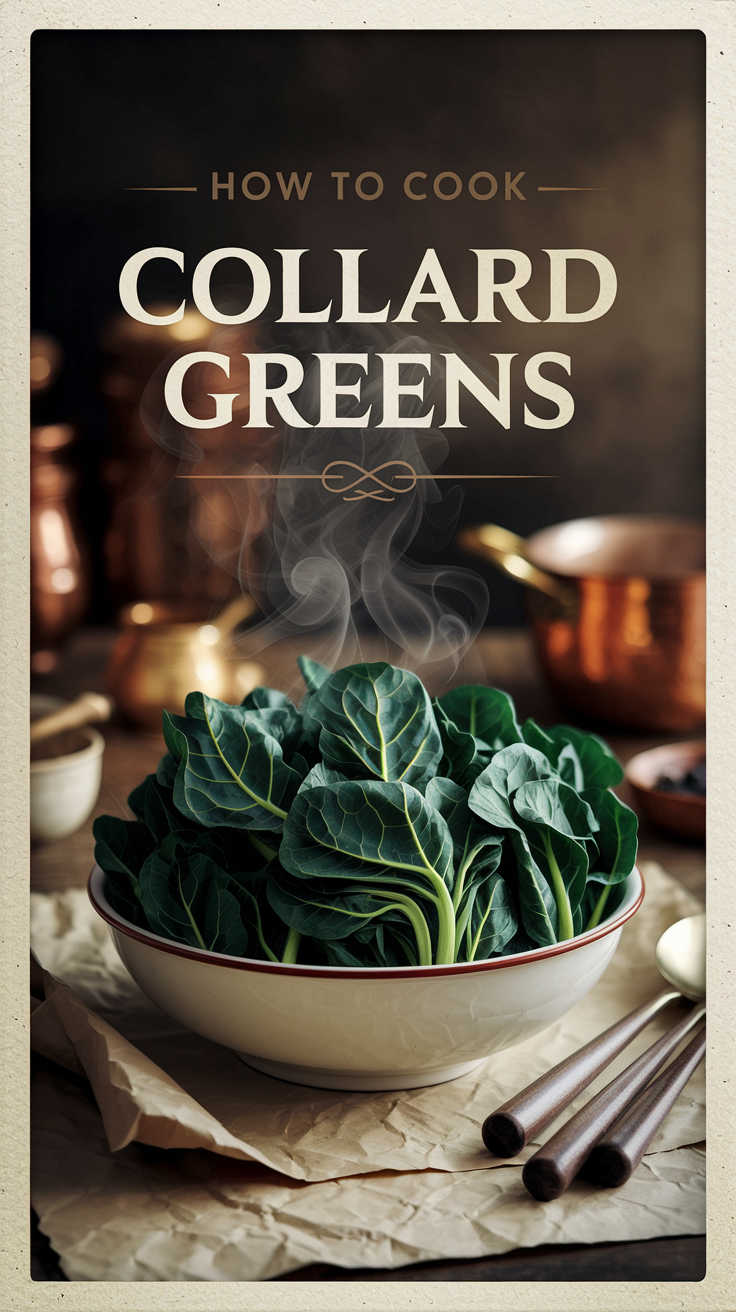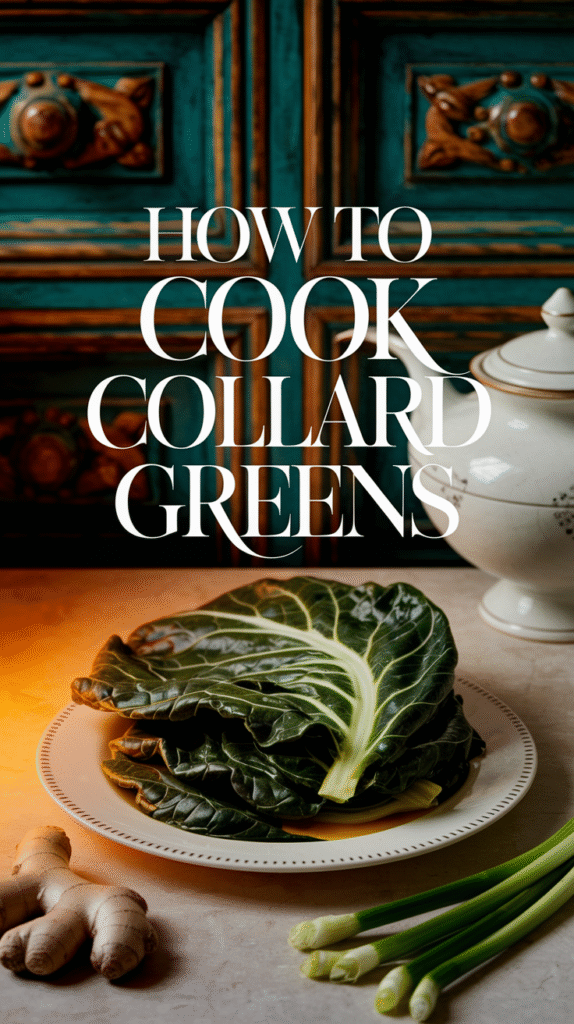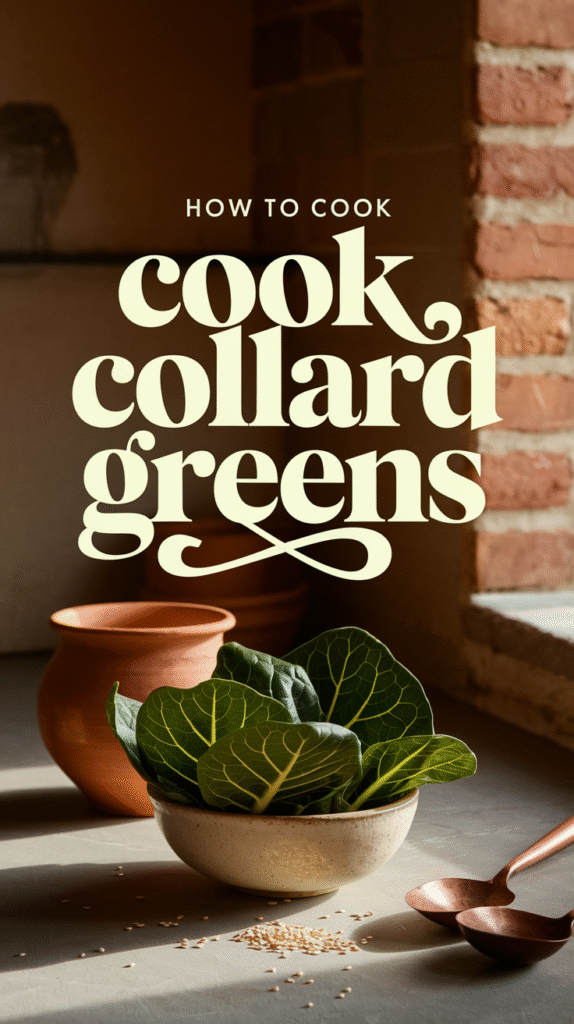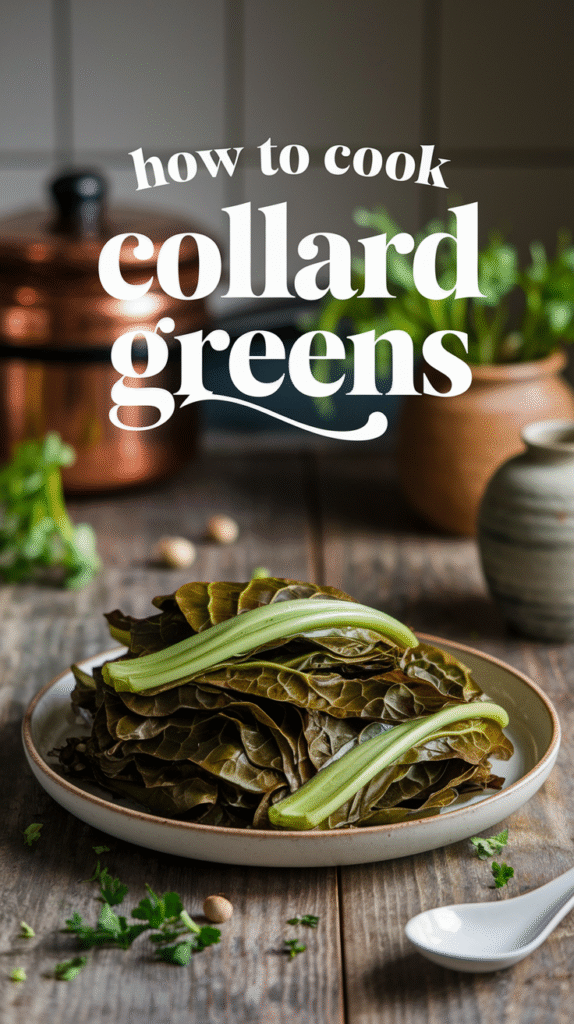Cooking collard greens can be a rewarding experience, offering a delicious way to enjoy this nutritious leafy vegetable. By exploring various techniques, you can maximize the flavor and enhance the overall dish. Here are some of the best methods to cook collard greens that will leave you and your guests craving more.
First, it’s essential to choose fresh collard greens. Look for leaves that are deep green, crisp, and free from yellow spots. You can find fresh collard greens at local farmers’ markets or grocery stores. Once you have your greens, wash them thoroughly to remove any dirt or grit.
Prep Your Collard Greens
Start by removing the tough stems. Hold the leaf in one hand and strip the stem with the other hand, discarding it. Stack several leaves together, and then slice them into bite-sized pieces. You can choose to chop the leaves into strips or small squares, depending on your preference.
Choose Your Cooking Method
There are several tried-and-true techniques for cooking collard greens. Here are some popular methods:
- Boiling: Bring a large pot of water to a boil. Add a pinch of salt, and then drop in the collard greens. Boil them for about 5-10 minutes until they’re tender. Drain and season with olive oil, vinegar, or your favorite spices.
- Sautéing: Heat some olive oil in a large skillet over medium heat. Add minced garlic, onions, or bell peppers for added flavor. Once the aromatics are sizzling, add your chopped collard greens. Sauté for 5-7 minutes until they soften. Mixing in a splash of vegetable broth can enhance the flavor.
- Steaming: Steaming keeps collard greens vibrant and preserves their nutrients. Use a steaming basket over a pot of simmering water. Cover and steam for 5-15 minutes, based on your desired tenderness.
- Slow Cooking: For a rich, deep flavor, slow-cooking collard greens can be a game changer. Combine collard greens with diced ham, some onion, and chicken or vegetable broth in a slow cooker. Let them cook on low for 4-6 hours. The result is beautifully tender greens with infused flavors.
Enhance with Flavorful Ingredients
Adding the right ingredients can elevate your collard greens dishes significantly. Here are some suggestions:
- Meat: Smoked turkey, bacon, or ham hocks can impart fantastic flavor. Adding a piece of meat while cooking allows the greens to absorb savory notes.
- Broth: Using chicken, vegetable, or beef broth instead of water can make the dish heartier and more flavorful.
- Spices and Herbs: Experiment with garlic, crushed red pepper flakes, black pepper, or vinegar. A touch of lemon juice or hot sauce can add a refreshing kick.
- Onions and Garlic: Sautéed onions and minced garlic can bring essential aromatics, enhancing the overall taste appreciably.
Serving Suggestions
Collard greens are versatile and can complement many dishes. Here are some delicious serving ideas:
- Serve as a side dish with cornbread and fried chicken.
- Incorporate them into soups or stews for added texture and flavor.
- Toss them into salads or grain bowls for a nutritious boost.
- Garnish with a sprinkle of cheese or nuts for added richness.
For further inspiration on collard greens recipes, you can visit Food Network or James Beard Foundation.
These techniques will transform your collard greens into a flavorful, enjoyable dish. Experiment with different methods, ingredients, and serving suggestions to find your perfect recipe. Enjoy cooking and savoring this delightful green!
Nutritional Benefits of Collard Greens You Should Know
Collard greens are a powerhouse of nutrients, making them a fantastic addition to your diet. Originating from the cruciferous vegetable family, these leafy greens boast numerous health benefits. Here’s an in-depth look at the nutritional benefits you should know about.
Rich in Vitamins and Minerals
Collard greens are loaded with essential vitamins and minerals. A single cup (cooked) provides:
| Nutrient | Amount per Cup (cooked) | % Daily Value |
|---|---|---|
| Vitamin K | 1045 mcg | 1313% |
| Vitamin A | 145 mcg | 16% |
| Vitamin C | 30 mg | 33% |
| Calcium | 268 mg | 27% |
| Iron | 2.2 mg | 12% |
| Folate | 178 mcg | 45% |
These vitamins and minerals contribute to several health benefits, such as supporting bone health, improving immune function, and maintaining healthy skin and eyesight.
High in Antioxidants
Antioxidants are crucial for fighting oxidative stress in the body. Collard greens are rich in flavonoids and carotenoids, which can help neutralize free radicals. This action may play a role in reducing the risk of chronic diseases, including heart disease and cancer.
Supports Digestive Health
In addition to being a nutritious option, collard greens are an excellent source of dietary fiber. A high-fiber diet has several benefits:
- Improves digestion: Fiber helps to keep the digestive tract running smoothly.
- Promotes regularity: It can help prevent constipation and promote regular bowel movements.
- Supports weight management: Fiber-rich foods help you feel full longer, aiding in weight control.
Boosts Heart Health
Including collard greens in your meals can contribute to a healthier heart. Their high fiber content and low-calorie nature make them ideal for managing cholesterol levels. Furthermore, the potassium found in collard greens helps regulate blood pressure, which is essential for overall heart health.
Bone Health Promotion
Due to their high levels of calcium and vitamin K, collard greens can support strong bones. Calcium is critical for maintaining bone density, while vitamin K helps improve calcium absorption, making these greens a vital food for bone health.
How to Incorporate Collard Greens into Your Diet
Integrating collard greens into your meals can be simple and delicious. Here are some ideas:
- Steamed or sautéed: Cook collard greens with garlic and olive oil for a tasty side dish.
- In salads: Use young collard greens as a base for salads, or chop them into slaws.
- In soups and stews: Add chopped collard greens to any soup or stew for added nutrients.
- In smoothies: Blend collard greens into your morning smoothie for a nutrient boost.
The culinary possibilities are endless when it comes to cooking with collard greens. Experiment with flavors that you enjoy to find the best combinations.
Final Thoughts
With their impressive nutritional profile and health benefits, collard greens are a must-include on your grocery list. They not only enhance meals but also contribute significantly to your overall health. Whether you’re looking to improve your heart, digestive, or bone health, adding collard greens to your diet can make a positive difference.
For more information about collard greens and their health advantages, you can visit Healthline or check out Medical News Today.
Traditional Southern Recipes Featuring Collard Greens
Collard greens are a delicious and nutritious staple in Southern cooking. These leafy greens are often enjoyed cooked down with various seasonings and ingredients. If you want to celebrate traditional Southern flavors, consider incorporating collard greens into your cooking. Here are some classic Southern recipes that highlight this healthy green.
Collard Greens with Ham Hocks
This is a beloved Southern dish that combines the rich flavor of ham hocks with the hearty texture of collard greens. Here’s a simple recipe:
- Ingredients:
- 2 pounds collard greens, cleaned and chopped
- 1 large onion, diced
- 3 cloves garlic, minced
- 1-2 ham hocks
- 4 cups chicken broth
- Salt and pepper to taste
- 1 tablespoon olive oil
- Red pepper flakes (optional)
- Instructions:
- In a large pot, heat the olive oil over medium heat.
- Add the diced onion and garlic. Sauté until they become soft.
- Stir in the ham hocks and chicken broth. Bring to a boil.
- Add in the chopped collard greens. Reduce heat and let it simmer for about 45 minutes to an hour, or until the greens are tender.
- Season with salt, pepper, and red pepper flakes if desired.
This dish is often served with cornbread, making for a comforting and filling meal.
Southern-Style Collard Greens Soup
This soup is hearty and packed with flavor. It pairs nicely with crusty bread and is perfect for a chilly day.
- Ingredients:
- 1 tablespoon olive oil
- 1 onion, diced
- 2 carrots, chopped
- 2 celery stalks, chopped
- 3 cloves garlic, minced
- 1 teaspoon thyme
- 2 cups collard greens, chopped
- 4 cups vegetable broth
- 1 can white beans, rinsed and drained
- Salt and pepper to taste
- Instructions:
- In a large pot, heat the olive oil over medium heat.
- Add the onion, carrots, and celery. Cook until soft.
- Stir in the garlic and thyme. Sauté for an additional minute.
- Add the collard greens and vegetable broth. Bring to a boil.
- Lower the heat and let it simmer for about 20 minutes.
- Incorporate the white beans and cook for another 5 minutes.
- Season with salt and pepper to your liking.
Collard Greens Salad
If you prefer a lighter option, a collard greens salad is refreshing and nutritious. This salad can easily be customized to your liking. Here’s a quick recipe:
- Ingredients:
- 4 cups raw collard greens, finely chopped
- 1 cup cherry tomatoes, halved
- 1 cup cucumber, diced
- 1 avocado, diced
- 1/4 cup red onion, thinly sliced
- 2 tablespoons olive oil
- 1 tablespoon apple cider vinegar
- Salt and pepper to taste
- Instructions:
- In a large bowl, combine all the chopped vegetables.
- In a small bowl, whisk together the olive oil, apple cider vinegar, salt, and pepper.
- Drizzle the dressing over the salad and toss gently to combine.
This salad offers a crunchy texture with all the nutritional benefits of collard greens!
Cooking collard greens is versatile, and these traditional Southern recipes are a great way to embrace their rich flavor and health benefits. Whether you prefer them cooked or raw, collard greens can be the star of your meal. For more detailed recipes and tips on cooking collard greens, check out Food Network or Epicurious.
Try these recipes at home, enjoy the delicious taste of Southern cooking, and share them with family and friends!
Creative Variations: Modern Twists on Cooking Collard Greens
Collard greens are a flavorful and nutritious green leafy vegetable that often find their way onto Southern menus. Traditionally, they are simmered with spices and often linked to rich culinary histories. However, modern cooks are breathing new life into this classic ingredient with creative twists and variations. Here, we’ll explore inventive ways to cook collard greens that transform them into vibrant dishes you’d want to share with family and friends.
1. Collard Greens Pesto
If you love pesto but want to add a healthy twist, collard greens make an excellent base. By blending collard greens with nuts, garlic, olive oil, and Parmesan cheese, you can create a flavorful sauce perfect for pasta, sandwiches, or even a topping for grilled chicken.
- 2 cups of collard greens, stems removed
- ½ cup of nuts (like pine nuts or walnuts)
- 2 garlic cloves
- ½ cup of grated Parmesan cheese
- ⅔ cup of olive oil
Blend all ingredients until smooth, adjusting the olive oil for your desired consistency. Store in the fridge for up to a week or freeze for future meals.
2. Collard Greens Stir-Fry
Stir-frying is a quick and healthy way to prepare collard greens. Combine them with other colorful vegetables like bell peppers, carrots, and broccoli for added flavor and crunch. Here’s a quick method:
- Chop collard greens into bite-sized pieces.
- In a large skillet, heat on medium-high and add a splash of sesame oil.
- Add minced garlic and ginger for a burst of flavor.
- Stir-fry the collard greens with other vegetables until tender yet vibrant.
Finish with a drizzle of soy sauce or a sprinkle of sesame seeds for added flair.
3. Collard Greens Smoothie
You might not expect greens in a smoothie, but adding collard greens will boost your nutrient intake without overpowering the flavor.
- 1 cup of fresh collard greens
- 1 banana
- ½ cup of Greek yogurt
- 1 cup of almond milk
- 1 tablespoon of honey (optional)
Blend all ingredients until smooth for a refreshing start to your day.
4. Collard Greens and Quinoa Salad
Add texture and protein to your meal with a collard greens and quinoa salad. This dish is easy to prepare and packs well for lunch. Combine cooked quinoa, finely chopped collard greens, chopped tomatoes, cucumbers, and a zesty lemon vinaigrette for a nutritious and satisfying meal.
- 1 cup of cooked quinoa
- 2 cups of collard greens, finely chopped
- 1 cup of diced tomatoes
- ½ cucumber, diced
- ¼ cup of olive oil and lemon juice for dressing
5. Collard Greens Soup
For a comforting option, consider a collard greens soup. Start with a base of sautéed onions and garlic, adding diced potatoes and broth, then stirring in collard greens as the last step. A splash of vinegar or a sprinkle of hot sauce can elevate the flavors even more.
6. Southern-style Collard Greens with a Twist
While Southern-style collard greens typically involve slow cooking with ham hocks, you can change it up by using smoked turkey or plant-based alternatives for a lighter version. Incorporate spices like cayenne and smoked paprika to retain that familiar flavor while giving it a modern touch.
Embracing these creative variations can make collard greens a versatile component in your cooking repertoire. Whether you’re jumping on the health trend or just looking to change things up, these twists will keep your meals exciting and nutritious.
For more inspiration on cooking collard greens and exploring various methods, check out The Kitchn and Simply Recipes.
These inventive approaches to cooking collard greens are sure to delight your taste buds while keeping meals fresh and exciting. So, gather your ingredients and get cooking—your next favorite dish might just be one of these modern twists!
Common Mistakes to Avoid When Cooking Collard Greens
When you’re eager to enjoy a delicious plate of collard greens, it is essential to avoid common pitfalls that can affect both the taste and texture. Below are some key mistakes to steer clear of for the best results.
Not Washing Collard Greens Properly
One of the most significant errors cooks make is neglecting to wash collard greens thoroughly. These leafy greens often harbor dirt and sand between the leaves. To ensure cleanliness, submerge the greens in a bowl of cold water, swish them around gently, and lift them out. Repeat this process until the water is clear. This simple step will enhance the flavor of your dish and provide a better experience.
Overcooking the Greens
Collard greens are known for their hearty texture, but overcooking can result in a mushy mess. Cooking them for too long can also diminish their vibrant color and nutritional value. Aim to cook for about 30 to 45 minutes, depending on your preferred tenderness. Test with a fork; if it easily penetrates the greens, you’re good to go. Keeping an eye on the clock ensures you achieve the right bite.
Skipping Seasoning
Don’t underestimate the power of seasoning when cooking collard greens. Just boiling them in water will leave you with a bland experience. Instead, consider using:
- Salt and pepper to enhance flavor
- Smoked paprika for a smoky twist
- Chili flakes for a kick of heat
- Garlic for aromatic depth
- Soy sauce or vinegar for acidity
Experiment with spices and find the combination that appeals to your palate.
Ignoring the Cooking Liquid
The liquid you use can profoundly impact the flavor profile of your collard greens. While water is a common choice, using chicken broth or vegetable stock can elevate your dish to gourmet status. Additionally, adding a splash of vinegar or hot sauce can enhance the greens’ natural flavors. Always taste the liquid before adding it to the greens to ensure it aligns with your desired flavor.
Not Removing the Stems
Collard greens have tough stems that can be unpleasant to eat. If you’re looking for a tender bite, take a moment to trim the stems. Hold the leaf in one hand and gently pull the stem with the other to separate it from the leafy part. This simple step makes a world of difference in both texture and enjoyment.
Using Cold Oil
If you’re sautéing collard greens, using cold oil can cause them to steam rather than sauté. Heat your oil in the pan before adding the greens. This helps to seal in their flavor and creates a pleasing caramelization effect. Olive oil, bacon grease, or even flavored oils work well and bring complexity to the dish.
Forgetting to Toss in Other Ingredients
Collard greens can play nicely with a variety of other ingredients. Ignoring the potential for combination can lead to missed flavor opportunities. Consider adding:
- Sliced onions or shallots for sweetness
- Crumbled bacon or ham for savory depth
- Tomatoes for acidity and moisture
- Beans for heartiness
By incorporating these elements, you create a satisfying meal that highlights the collard greens.
Not Allowing Time to Rest
Once your collard greens are cooked, let them rest for a few minutes before serving. This allows the flavors to meld together effectively, enhancing the dish’s overall taste. If you dive right in, you may miss out on the depth of flavor that develops during this time.
If you’d like to explore more ideas and tips on cooking collard greens, check out Food Network and Serious Eats. With these resources, you can deepen your knowledge and skills.
With these strategies in mind, you’ll be better equipped to create flavorful collard greens that stand out at any meal. Avoid these common mistakes, and enjoy a healthier and tastier dish!
Conclusion
Mastering the art of cooking collard greens can transform your meals into flavorful, nutritious experiences. By employing the best techniques—like slow-cooking for maximum flavor or opting for a quick sauté—you can elevate this leafy green to new heights. The nutritional benefits of collard greens are impressive as well, offering a bounty of vitamins and minerals that support your health and well-being.
Embracing traditional Southern recipes allows you to appreciate the cultural significance of collard greens while enjoying comforting dishes that have stood the test of time. Don’t be afraid to experiment with creative variations, adding unique ingredients or modern twists that suit your palate. Whether it’s a spicy kick or an unexpected ingredient, these innovations can breathe new life into a beloved classic.
However, as you embark on your collard greens journey, remember to avoid common pitfalls. Overcooking, neglecting seasoning, and skipping the cleaning process can diminish the vibrant goodness that collard greens offer. By paying attention to these aspects, you can ensure that your dishes are both delicious and healthy.
Cooking collard greens not only allows you to enjoy a tasty meal but also introduces you to a world of culinary creativity. With the insights and techniques discussed, you are now equipped to explore this versatile vegetable and make it a star in your kitchen. Enjoy the journey of discovering how to cook collard greens, and watch as they become a delightful staple in your culinary repertoire.







Leave a Reply